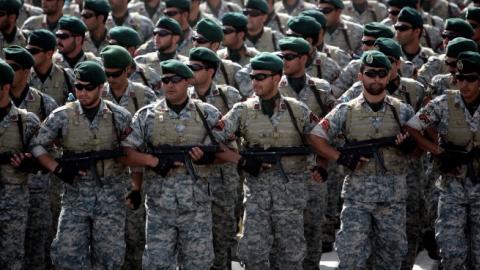The ouster of ISIS fighters from Tikrit, Saddam Hussein’s hometown, has been widely celebrated. Although this victory was brought about in no small part by American airpower, it was a triumph for Iran more than for the United States. The vast majority of fighters on the front lines belonged to Shiite militias, many of them trained, equipped, and advised by the Iranians. Their de facto commander is Gen. Qassem Suleimani, head of the Iranian Revolutionary Guard Corps’s Quds Force, which is charged with exporting the Iranian revolution. He has become a seemingly ubiquitous presence on the front lines, his appearances celebrated through a clever Iranian social media campaign. Iranian T-72 tanks and even Fajr-5 artillery rockets and Fateh-110 missiles are now appearing in Iraq as well.
What’s Iran up to? Most commentators emphasize the fight against ISIS, but the transfer of heavy weaponry, which is of limited use in the Tikrit campaign, implies a wider agenda. A few observers have suggested that Tehran wants to “Finlandize” Iraq. But that’s not quite right. Iran won’t be satisfied if Iraq merely adopts a neutral posture. Tehran wants to achieve something more ambitious: It seeks nothing less than to “Lebanonize” Iraq.
Although Lebanon and Iraq are very different, they have striking resemblances. Both were cobbled together out of provinces of the Ottoman Empire, and both are complex ethnic mosaics in which a large Shiite underclass was denied power for decades. In the late 1970s and early 1980s, Lebanon was in the throes of a civil war and Iran was undergoing a revolution. Even as they were fighting to take power in Tehran, Iranian revolutionaries exploited the chaos in Lebanon to organize Hezbollah (the Party of God), a Shiite militia subservient to Tehran. For local consumption, Hezbollah emphasizes its popular, Lebanese roots and claims that it sprung up spontaneously to resist the 1982 Israeli invasion. By presenting itself as the defender of all Arabs against the “Zionist entity,” Hezbollah seeks to overcome the traditional Sunni distrust of Shiites.
For many years, Western analysts tended to take Hezbollah’s propaganda at face value. Today, however, Hezbollah’s deep participation in the Syrian civil war (in which Israel is largely a bystander) demonstrates that it has no qualms about training its guns on fellow Muslims in order to protect Iranian interests. Its intervention in Syria was the key factor that saved the regime of Bashar al-Assad, Iran’s greatest ally, and it has also supported Iranian initiatives elsewhere in the Arab world, including in Iraq.
But of course its primary mission is to keep Lebanon in the orbit of Tehran. It does so not by ruling directly but by using extortionate methods, forcing Lebanese leaders to give it complete freedom of action in key domains, security first and foremost. Thus it deploys, with no governmental oversight, some 50,000 Iranian-supplied missiles and rockets aimed at Israel. To maintain the support of its Shiite constituents, Hezbollah runs hospitals, schools, and other social-welfare activities funded by Iran as part of a subsidy believed to total $100 million a year.
The U.S.-led invasion of Iraq gave Iran the opportunity to export this Hezbollah model to its Arab neighbor. Starting in 2003, Iran supplied money, weapons, and training to numerous Shiite militias in Iraq, such as the Mahdi Army, the Badr Brigades, Asaib Ahl al-Haq, and Khataib Hezbollah. At first, the chief goal of the militias was to drive out U.S. forces, which served as the major obstacle in their path to power. They accomplished that objective in 2011 when President Obama failed to negotiate a Status of Forces Agreement. Today it is the Sunni jihadists who preoccupy the militias. But just as Hezbollah was never simply the homegrown counterweight to Israel that it pretended to be, so we should not today see the Iraqi militias as bands of local boys spontaneously organizing to protect embattled Shiites from ISIS. Iran has larger purposes. It seeks, in the near term, to consolidate its control of Iraq. After that, it will use Iraq as another springboard to further expand its power in the Arab world.
The first part of this plan is already far advanced. The Iraqi Army, which had been compromised by corrupt and sectarian officers appointed by the Iranian-backed prime minister Nuri al-Maliki, all but collapsed after the fall of Mosul in June 2014. Iranian-backed militias are now the dominant military force in Iraq, with estimates of their strength at 100,000 to 120,000, while the Iraqi Army’s effective strength has fallen under 50,000. The Obama administration was proud of helping to oust Maliki from power in September 2014. And it is true that his replacement as prime minister, Haider al-Abadi, is a more moderate and less sectarian Shiite. But he is far from the most powerful man in Iraq. That honor belongs to General Suleimani, followed by his top henchmen, such as Hadi al-Ameri of the Badr Organization. Not only do they control a vast network of militiamen, they also indirectly control Iraq’s police forces: The minister of interior is a Badr member.
Instead of actively opposing Iranian designs, the White House gives every indication of acquiescing in them, because it views Iran as a valuable ally in the war against ISIS and because it does not want to hinder the possibility of a nuclear accord with Iran. By bombing in Tikrit, Obama turned the U.S. Air Force, in effect, into the Iranian Air Force—a model that is likely to be followed in Mosul as well.
Turning a blind eye to Iran’s growing role in Iraq is a far greater miscalculation than allowing Iran to consolidate its power in Lebanon, a much smaller and less strategically important state. Iraq has the world’s fifth-largest proven oil reserves and the second-largest in OPEC. With Iran now dominating the security sector of Iraq, it is only a matter of time until it takes control, directly or by proxy, of the southern oil fields, which lie in the Shiite heartland. With these oil reserves under its control, and with nuclear sanctions lifted, Iran would become overnight the dominant player in OPEC and hence one of the dominant forces in world energy markets.
And it is not just the Iraqi oil fields that we need to worry about. Remember that Iranian domination of Lebanon has allowed Hezbollah to project its power against both Israel (in the form of rocket attacks and cross-border raids) and Syria (in the form of military aid that allows Assad to remain in power). Iraq is nextdoor to Kuwait, the country with the seventh-largest proven oil reserves, and Saudi Arabia, with the second-largest proven oil reserves. Imagine if Iran were to use its newfound power base in Iraq to intimidate or even invade its oil-rich neighbors—something that is by no means unthinkable given that many Iraqis (and not just the late Saddam Hussein) regard Kuwait as their country’s 19th province, and given that Saudi Arabia’s oil fields are located in that country’s eastern provinces, where there is a substantial Shiite underclass. Iran, whose leaders still chant “Death to America,” would then cement its position as the dominant force in the Middle East, giving a sinister meaning to the term Persian Gulf.
Rather than giving Iran a free hand to “Lebanonize” Iraq (and its neighbors), Obama would be better advised to hark back to an alternative policy enunciated by another Democratic president—Jimmy Carter. Following the Soviet invasion of Afghanistan in 1979, Carter proclaimed: “An attempt by any outside force to gain control of the Persian Gulf region will be regarded as an assault on the vital interests of the United States of America, and such an assault will be repelled by any means necessary, including military force.”
The Carter Doctrine was aimed explicitly at the Soviet Union because of fears that the Soviet conquest of Afghanistan was only a prelude to a thrust toward the Gulf and its oil riches. But it was also a response to developments such as the Iranian revolution of 1979 and the temporary takeover of the Grand Mosque in Mecca by Juhayman al-Utaybi, a precursor of Osama bin Laden. Fearing that U.S. allies such as Saudi Arabia could fall, Carter set up the Rapid Deployment Force, which morphed under the Reagan administration into Central Command, the U.S. military organization charged with defending American interests in the Gulf region.
Thus the Carter Doctrine laid down a “red line”: No single power would be allowed to dominate the Gulf, much as Britain for centuries hewed to a policy of allowing no single power to dominate the European continent. The Carter Doctrine, if it were still operative, would necessitate the Obama administration’s coming up with a strategy to prevent the Lebanonization of Iraq and the expansion of Iranian power to Syria, Yemen, and other countries as well.
The keystone of this strategy would be for the United States to do more to support its traditional allies against Iran—not only states such as Jordan, Saudi Arabia, and the United Arab Emirates, but, even more important, Sunni communities in Iraq and Syria that are most directly threatened by Iranian designs. Some analysts are now claiming that the United States has gotten a start in this direction by offering intelligence and other help to Saudi forces bombing Iranian-backed Houthis in Yemen. But the Saudis took the decision largely on their own. According to General Lloyd Austin, the commander of Central Command, Riyadh gave him only one hour’s warning before launching the intervention. Clearly, the Saudis no longer trust Washington. Regaining the trust of traditional allies should be the first order of business for the United States. But that would require the Obama administration to rethink its policy of outreach to Iran, which has left the United States to take a back seat in the region to Qassem Suleimani and the Quds Force.
__This article originally appeared in the April 20, 2015, Vol. 20, No. 30 issue of the Weekly Standard.__
















